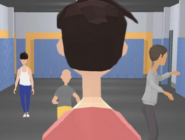MiSide
Advertisement
Advertisement

MiSide thrusts players into an absorbing first-person adventure set within the ever-changing virtual apartment of Mita. This dynamic environment serves as the primary stage for the game, where players explore various rooms, each detailed with objects that players can interact with to solve puzzles or uncover hidden secrets. The game evolves from simple exploration to more complex interactions, where players engage in mini-games ranging from competitive PvP sessions with Mita herself to solo challenges like operating arcade machines. As the plot thickens, the game’s atmosphere shifts from puzzling curiosity to stealth and suspense, offering a diverse gameplay experience.
From a Simple App to a Complex Reality
The storyline of MiSide begins with a male character, whose name is decided by the player, downloading an app named MiSide on his smartphone. This app, initially appearing as a straightforward 2D life-simulation game, takes a surreal turn on the 37th day when Mita expresses a desire to meet the player in person. This request triggers a transition from the smartphone to a 3D game world, where the player finds himself on a couch in Mita’s virtual apartment. As the player spends time with Mita, engaging in console games and routine activities, strange occurrences start to unfold, revealing a deeper, darker undercurrent to their seemingly benign interactions.
A Descent into Digital Madness
The game intensifies when the player attempts to investigate strange noises coming from a closet, only to be thwarted by Mita. Her sudden sinister transformation leads to a terrifying chase sequence, culminating in the discovery of a key in the closet that unlocks a basement door. Here, the player meets a benevolent version of Mita, who reveals that the hostile Mita is an aberration, created to trap men within the game and transform them into cartridges for her amusement. The good Mita advises reaching the “core” of the game world to reboot the malevolent Mita, aiming to erase her memories and end her reign of terror. This revelation sets the stage for a deeper exploration into earlier versions of the game, encountering various iterations of Mita, each with unique characteristics and some as glitches, further enriching the game’s narrative and complexity.
Related games
Comments















